Use 'Print preview' to check the number of pages and printer settings.
Print functionality varies between browsers.
Printable page generated Thursday, 18 April 2024, 9:44 AM
Study Session 3 Existing WASH Service Provision
Introduction
Protecting our environment is vital for the healthy and productive livelihood of urban communities. Healthy communities are crucial for sustained economic development. One of the important mechanisms through which the health and well-being of communities can be assured is the provision of safe, adequate and affordable WASH services.
In this study session, you will learn about key WASH service areas that are necessary to reduce or eliminate the risks of environmental pollution and ensure the health and safety of urban communities.
Learning Outcomes for Study Session 3
When you have studied this session, you should be able to:
3.1 Define and use correctly each of the key words printed in bold. (SAQ 3.1)
3.2 Briefly describe key WASH services in urban settings and give examples of service providers. (SAQ 3.1)
3.3 Describe the specific challenges posed by peri-urban and slum areas as attempts are made to improve access and use of WASH services. (SAQ 3.2)
3.4 List the key government offices at local level that are responsible for regulating WASH services, and describe their roles. (SAQ 3.3)
3.1 What are WASH services?
You were briefly introduced to services in Study Session 1. Services are systems that supply a public need, for example transport, communications, waste management or utilities such as electricity and water.
How were WASH services defined in Study Session 1?
WASH services are systems that provide for the water, environmental, sanitation and hygiene needs of communities.
Water supply utilities, solid waste management systems, and liquid waste collection and disposal systems are all examples of WASH services in urban areas. These systems are intended to protect the urban environment, as well as ensure that the water, sanitation and personal hygiene needs of urban communities are met.
There are different costs associated with the provision of WASH services. These include the initial investment cost, which is usually large, the operation and maintenance costs, and also future replacement and/or upgrading costs. The initial investment cost is usually paid for by communities, for example through taxes or other means. Such services financed by public money are known as public services.
In some towns, privately operated systems may exist. For example, as you read in Study Session 1, solid waste collection and disposal is increasingly becoming a service provided by organised youth groups through micro- and small enterprises (MSEs). In industrialised countries, private companies often take a significant role in the provision of WASH services including septic sludge emptying, operation and/or maintenance of water distribution systems, and installation and management of public latrines. Such companies that are privately owned and involved in service provision are called private service providers.
Increasing demand for improved WASH services in urban areas, coupled with the ever-increasing population, means that public or private providers alone may not be able to provide adequate services. Joint partnership between public and private service providers is an increasingly preferred and effective approach that improves service levels of WASH facilities. The solid waste collection scheme in most Ethiopian towns is a good example of such a public–private partnership (Figure 3.1).
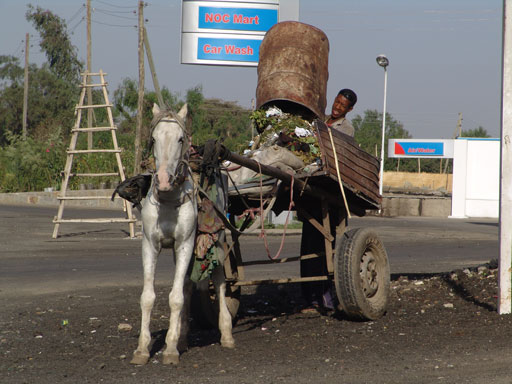
3.2 Key service areas in urban WASH
As discussed in Study Sessions 1 and 2, urban communities contribute to environmental pollution in many ways. To effectively reduce the impact of such pollution on the environment and its negative effect on the health of the public, it is critically important that service providers are mindful of pollution issues and work efficiently.
There are three key service areas in the WASH sector: water supply, liquid waste and solid waste management services.
3.2.1 Water supply services
Water supply includes the source of water, treatment plant, reservoir and tanks, main trunk lines, distribution lines and individual connection lines for the delivery of potable water (Ministry of Works and Urban Development, 2006). (Potable water is water that is safe to drink.) Treatment systems are not needed where sources are known to be clean and safe, for example water from protected springs and boreholes (Figure 3.2).
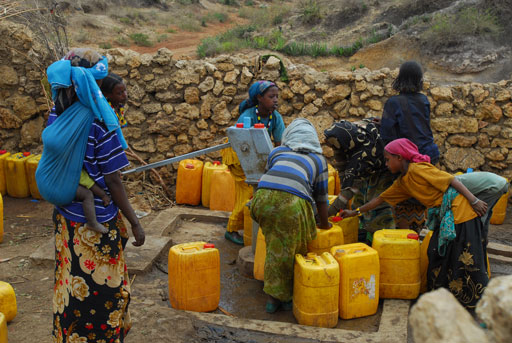
Due to the large number of different components required for an efficient system, water supply services require substantial investment. Governments may take loans from international development banks and other foreign agencies to finance large urban infrastructure projects, but in general most of this investment is obtained from the public in the form of tax.
Water supply systems also require adequate finance to operate and function properly. This cost is usually recovered from revenue generated as users pay for the services they get, and depends on the volume of water consumed over a period of time.
An adequate level of service for urban water supply was defined in 2011 as a minimum of 20 litres of clean water for one person per day, accessible at a distance not exceeding 500 m (MoWE, 2011). (Note that this figure has since changed and the minimum urban water supply service standard is now 40 litres/person/day within a distance of 250 m (MoWIE, 2015).) Based on this service level, water supply coverage in urban areas reached 81.3% in 2012/13 (MoFED, 2014). This indicates that a high proportion of the urban population can access an adequate supply of water. However, those living in slum areas often have to buy water from water vendors. They could be paying up to ten times more than those with access to piped water, for water of dubious quality.
Providing an uninterrupted supply of water is a huge challenge for most towns due to limited finance, equipment or manpower. Some sectors of the urban population get more water, while others get only a limited amount. For example, town centre families with higher than average income and water taps on their premises may get a lot more than 20 litres per person per day. Alternatively, poor families who live in peri-urban areas or slums may use less than five litres per person per day.
3.2.2 Sanitation and sewerage services
Figure 3.3 shows 2012 data on access to different types of sanitation facilities in Ethiopia. It shows that the situation in urban areas is much better than in rural parts of the country. However, 8% of the urban population still practised open defecation at that time. This is an estimated 1.2 million people, equivalent to almost 40% of the population of Addis Ababa or more than four times the population of Gondar or Dire Dawa.
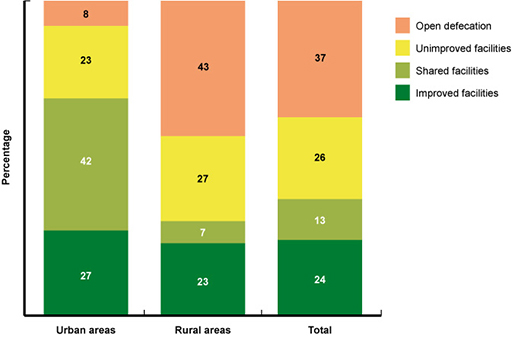
In addition to urban and rural differences, economic status has a significant impact on sanitation access. Figure 3.4 shows the percentage of high and low-income communities in Ethiopia with access to latrines. Of those in the richest communities, only about 8% used open defecation in 2012 and 92% of the community used latrine facilities of some kind. However, in the poorest communities, 78% of the people used open defecation and only 22% used latrine facilities. Although the government of Ethiopia is making an effort to provide services equitably, more work is needed to achieve desired levels of service provision, especially to poorer communities.
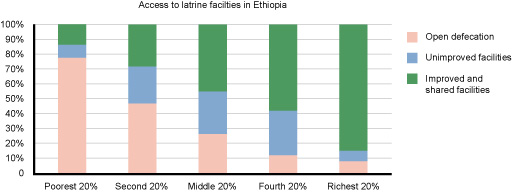
Water-flushed toilets need to be connected to a septic tank or to a sewer network. A sewer network includes a system of underground lines (pipes) for collecting and removing liquid wastes from residential, commercial and industrial sources (MoWUD, 2006). The sewerage system is used for two major liquid waste categories: blackwater and greywater.
What is meant by the terms greywater and blackwater?
Greywater is liquid waste from showers, wash basins, dish washing in kitchens and clothes washing. Blackwater is the water flushed from toilets and contains faeces and urine. (You read about this in Study Session 2.)
Most towns and cities in Ethiopia do not currently have a sewer network or sewage treatment system. (Sewage means combined greywater, blackwater and other wastewater. It is not the same as sewerage, which means the network of pipes that carry sewage.) In Addis Ababa some central areas have sewerage services that collect and transfer sewage to the treatment works. Elsewhere people rely on septic tanks and pit latrines. These both need regular emptying to safely remove and dispose of faecal sludge.
The local municipality may provide emptying services using vacuum trucks. These trucks provide collection and transport of faecal sludge from households and institutions on a needs basis. Although published statistics are not available, it is often the case that the available trucks cannot meet the demand and users may have to wait to get the service. The waiting time can vary between weeks and months, depending on the available equipment and manpower. Such vacuum truck services may not only be unavailable but also unaffordable.
3.2.3 Solid waste management services
Solid waste management services are another key service area in the WASH sector. Efficient solid waste management is critical for the well-being of urban communities. Without this service, solid waste can accumulate and quickly become a health risk. Figure 1.4 of Study Session 1 shows such a situation.
Solid waste management systems include collection, transport and final disposal systems. With the 3 R approach in mind, waste management may also include separating waste into its different components (glass, metal, plastic, paper, etc.) so that some of the waste can be reused or recycled. Infrastructure and equipment for solid waste management is usually paid for by the government and is therefore a public service. However, there are initiatives in most towns to engage private operators in one or more components of the waste management system.
The solid waste service is usually a low priority service, particularly in small and emerging towns. The general trend is that solid waste management does not become a critical concern until the point where accumulated waste has already become unsightly and caused inconvenience to communities, as illustrated in Figure 3.5.
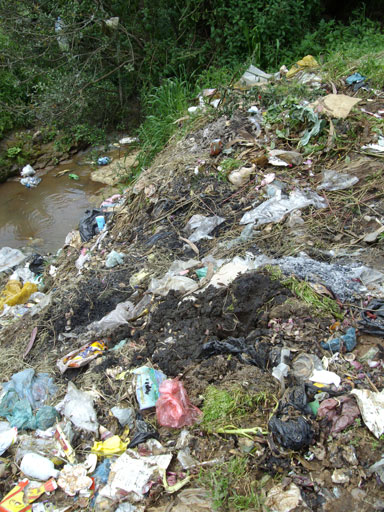
Information about access to waste management services in urban areas is not as easily available as information on other services, so less detailed data can be presented here than for water supply and sanitation services. Moreover, since service levels are not clearly defined, it is impossible to accurately and objectively determine the service coverage. However, larger towns that produce significant quantities of waste tend to have better established systems. Some towns in Ethiopia such as Addis Ababa and Bishoftu have invested in building solid waste disposal sites, but many are still not able to cope with the increasing demand (Figure 3.6).
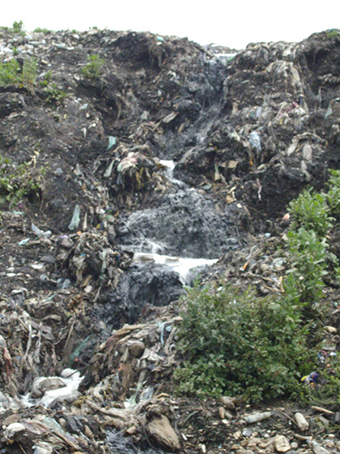
Which of the three key WASH service areas for urban areas, would be involved in:
- a.disposing of household plastic waste
- b.providing clean piped water
- c.disposing of septic sludge?
The answers are as follows:
- a.Solid waste management services
- b.Water supply services
- c.Sanitation and sewerage services.
3.3 Service provision arrangements
The key WASH services that you learned about in Section 3.2 are largely public services, paid for by the communities and administered by local government. In this section, you will learn how the provision of these services is organised and managed.
Water supply utilities
Water supply services are managed by organisations called utilities. Water utilities take overall responsibility for operating, maintaining and managing the water supply system. Utilities collect money from users based on the amount of water used. They use this to cover the costs of supplying the water including staff costs, office running costs and reserve capital for maintenance works.
The Town Water Board oversees the performance of the utilities. The board also helps to address challenges or issues as they occur in the course of operating and managing the water supply system. It comprises influential people from the Mayor’s office, sector offices and other relevant organisations.
Water supply and sewerage utilities
Water supply and sewerage services are often managed by a single utility. This is common in large towns, for example, Addis Ababa Water and Sewerage Authority (AAWSA), Bahir Dar City Water Supply and Sewerage Service, Hawassa Town Water Supply and Sewerage Service Enterprise.
Utilities for sewerage services are organised in a very similar way to water supply utilities. Slightly different modalities are used to recover regular costs, for example for sewerage services the payment is included in the fee for water supply. This addition can include fixed fees that all users pay and fees as a percentage of the consumed water. This is fair because the volume of sewage produced by a household or other user will be proportional to the volume of water used. For septic tank emptying services, utilities usually charge their customers a fixed amount per service.
Solid waste management services
Municipal authorities of towns and cities often provide solid waste management services, from collection to transport and final disposal. In recent years, departments with responsibility for ‘town greening and beautification’ have been created in municipalities of some towns and cities. Their main role is to ensure that unsightly spots in the town are well maintained and that the urban environment is attractive for the community. As part of their routine tasks, they may provide waste collection, transport and disposal services for households and institutions.
As you have read, micro- and small enterprises (MSEs) also play a significant role in solid waste management. It is common in many towns to see MSEs contracted by municipalities to provide solid waste management services.
Look back to Figure 3.1. It shows an example of a public–private partnership. Identify the public providers and the private providers in this example, and their common goal.
The municipality represents the public provider, and the MSE represents the private provider. Both are in partnership for the common goal of increased efficiency in solid waste management.
Private providers can usually offer a service that is better suited to communities, although this comes with a slightly higher cost than that of public providers. In view of the higher quality (reliability and continuity) of service, the slight addition in cost is generally considered acceptable. If correctly implemented, increasing public–private partnerships can help public service providers to focus on regulating services as well as ensuring the quality of service.
However, the role of the private sector has yet to grow large enough for the WASH sector to benefit. More companies that are both entrepreneurial and visionary are needed to strengthen the partnership with public providers. The lack of appropriate private providers contributes to the limited number of partnership arrangements in practice. In addition, WASH as a business is not generally very attractive to private entrepreneurs. Unlike luxury services and products, WASH services are basic and therefore only nominal charges can be applied. This directly affects the available profit margin and so makes it less attractive to business.
Name the providers for key WASH services in urban areas. For each service provider, describe the main focus of their services.
The main service providers are:
- water supply utilities, which serve urban communities by providing adequate clean water at affordable prices
- sewerage utilities, which serve to maintain the infrastructure for collection, transport and disposal of liquid waste from households and institutions
- MSEs – business organisations that work on waste collection and transport.
You might also have mentioned the town greening and beautification department, which is supposed to ensure that the urban environment is pleasant for the community, and town municipalities, which may provide waste collection, transport and disposal services to households and institutions.
3.4 WASH service provision for low-income communities
People on little or no income tend to live in peri-urban areas and slums.
What are the main characteristics of peri-urban and slum areas?
These areas are characterised by dense populations, poor quality housing, lack of proper access to infrastructure such as roads, and lack of basic services such as water supply, sanitation and waste disposal.
In Study Session 1 you were introduced to the key challenges of WASH service provision in urban areas. You learned that communities living in slums and peri-urban areas of towns and cities are among the least served segments of the urban population.
Look at the percentages of the population with access to improved or shared latrine facilities shown in Figure 3.5 and compare the percentage for the richest 20% of the population with that for the poorest 20%.
According to Figure 3.5, 85% of those in the richest 20% of the population have access to improved or shared latrine facilities. In comparison, only 15% of those in the poorest 20% of the population have access to such facilities.
You also learned in Study Session 1 that the poor and other vulnerable communities are forced to live in peri-urban and slum areas. They have no choice. Poor people cannot afford to live in areas where basic services are easily accessible so they are forced to live in areas within or on the fringes of the urban area where infrastructure has not reached. Settlement in these areas is illegal because the inhabitants do not have the proper permits to occupy the land and therefore the government may not be able to invest in new infrastructure in these areas.
Providing short-term solutions in such areas is also challenging because the settlements in them are informal and unplanned without proper access roads and pathways. Even when such solutions are introduced, it is difficult to provide continuous support and follow-up for the proper use and management of the facilities by the community. There are therefore huge difficulties for government and other stakeholders involved in improving WASH situations in these areas.
As a result, the most vulnerable communities live in conditions where they are constantly exposed to critical health risks (see Study Session 1, Figure 1.3). Urban communities and local government are faced with the challenge of working together to change this situation, and improve WASH facilities for the most vulnerable.
3.5 Regulation of WASH services
In addition to the service providers, there are also important stakeholders who regulate and control the services they deliver. Their major role is to ensure that the quality and quantity of the service provided by WASH facilities complies with existing standards for urban communities in Ethiopia. They also work towards equity of access, trying to ensure fair distribution of facilities and services to all parts of the urban population.
| Regional Water Bureau and Woreda Water Desk | Regional Health Bureau and Woreda Health Office | Municipality | |
| Regional | Proclamations and legislation to improve service provision by utilities Legalisation of water utility enterprises or companies Inspection of water supply facilities, services and standards | Registration and licensing of health professionals Inspection of healthcare services and standards Setting regulations, directives and guidelines | Not applicable |
| Woreda (works with regional counterparts) | Water quantity, water quality assurance Construction quality assurance during expansion or upgrade of facilities | Water quality inspection Healthcare service inspection Sanitary service inspection | Quality and coverage of waste management and disposal services Land development planning to accommodate WASH facility needs Construction quality assurance |
Table 3.1 summarises some of the important roles in regulating WASH services in urban areas. Notice that all the stakeholders in this table are government institutions. It is the duty and responsibility of the government structure to ensure that adequate, safe and environmentally friendly services are provided to communities.
The responsibility for regulating WASH services is decentralised down to the woreda level, empowering local government administrators to assure the quality and quantity of service provided to communities.
Name the key government offices at woreda level that are responsible for regulating WASH services. Refer to Table 3.1 and explain the roles of each.
The answers are as follows:
- Woreda Water Desk – confirms the quality and quantity of water supply, in collaboration with regional counterparts.
- Health Office – inspects water quality and healthcare services.
- Municipalities – include or certify WASH facilities location in town-wide land development plans, as well as the quality and coverage of waste management and disposal services.
Summary of Study Session 3
In Study Session 3, you have learned that:
- WASH services provide the water, sanitation and hygiene needs of urban communities. These include water supply systems, sanitation services and waste management services.
- Water supply services consist of the provision, operation and management of infrastructure for withdrawal (from the water source), treatment and distribution of clean water to communities.
- Sanitation or sewerage services consist of household, institutional and public latrines and the system for collecting and safely disposing of sludge from septic tanks and pit latrines.
- Waste management services include the complete chain of service from waste collection and transport to final disposal, and the management and administration of equipment and infrastructure related to the service.
- WASH services in urban areas are delivered through utilities and municipalities. Utilities are semi-private organisations that provide water supply and sewerage services, septic sludge collection and disposal services to urban communities at affordable prices. Water supply and sewerage utilities recover their expenses through tariffs collected from users.
- Municipalities provide solid waste collection, transport and disposal services. Micro- and small enterprises may partner with municipalities in public–private partnerships.
- Slums and peri-urban areas, characterised by informal and unplanned settlement, with little or no basic services and poor access, pose particularly difficult challenges for provision of WASH services.
- WASH service provision is regulated by government sector offices at both regional and woreda level.
Self-Assessment Questions (SAQs) for Study Session 3
Now that you have completed this study session, you can assess how well you have achieved its Learning Outcomes by answering these questions.
SAQ 3.1 (tests Learning Outcomes 3.1 and 3.2)
For each of the key WASH services listed below, identify the important service providers at a town level.
- a.Water supply services
- b.Solid waste disposal services
- c.Liquid waste disposal services.
Answer
The important WASH service providers at town level are as follows:
- a.For towns of moderate to large size, utilities provide water supply services. (You may also have mentioned WASHCOs, which may be involved in providing water supply services in small towns; you will learn more about this in Study Session 7.)
- b.Solid waste disposal services are provided by municipalities in partnership with MSEs.
- c.Utilities provide sewerage or liquid waste disposal services, if these are present.
SAQ 3.2 (tests Learning Outcome 3.3)
Describe three specific challenges posed by peri-urban areas and slums for improving access and utilisation of WASH services.
Answer
Urban communities living in slums and peri-urban areas have particular characteristics that make it challenging to provide sustainable WASH services. These are:
- Poverty: Communities are usually very poor and cannot pay for improved services.
- Lack of infrastructure: These areas have little or no infrastructure and often there are no access roads. In the absence of access roads, bringing WASH services to residents of slum areas is impossible or very challenging.
- Unplanned settlement patterns: These are a key feature in peri-urban and slum areas. This makes it difficult to provide basic infrastructure, including WASH services. Roads, water supply networks and public latrines with proper access for sludge removal are lacking. The settlement pattern also hinders attempts to plan interventions that can improve the situation.
- Illegal settlement: People living in slum areas and at times in peri-urban areas have no legal status, which automatically makes it impossible to improve the WASH situation. For example, utilities provide connections to legally owned premises but most slum dwellers do not have these rights. The case of latrine construction is similar.
SAQ 3.3 (tests Learning Outcome 3.4)
For each of the following government offices, select the description below that accurately depicts its role in the regulation of WASH services.
Regional Water Bureau; Woreda Water Desk/Office; Regional Health Bureau; Woreda Health Office; municipality.
- Controls the quality and coverage of waste management and disposal services and provides land development planning to accommodate WASH facility needs in towns.
- Inspects healthcare and sanitary services. Also provides inspection of water quality.
- Establishes the legal grounds (e.g. regulations, directives and guidelines) to provide healthcare services to communities. Conducts inspections and monitors the service level that healthcare facilities provide. Registers and licenses healthcare professionals.
- Provides the legal framework (proclamations and legislations) to improve service provision by utilities. Conducts inspections of water supply facilities, services and standards.
- Provides quality assurance at town level including quantity and quality of water delivered. Supervises quality of construction during system expansion or upgrade.
Answer
- Municipality: Controls the quality and coverage of waste management and disposal services and provides land development planning to accommodate WASH facility needs in towns.
- Woreda Health Office: Inspects healthcare and sanitary services. Also provides inspection of water quality.
- Regional Health Bureau: Establishes the legal grounds (e.g. regulations, directives and guidelines) to provide healthcare services to communities. Conducts inspections and monitors the service level that healthcare facilities provide. Registers and licenses healthcare professionals.
- Regional Water Bureau: Provides the legal framework (proclamations and legislations) to improve service provision by utilities. Conducts inspections of water supply facilities, services and standards.
- Woreda Water Desk/Office: Provides quality assurance at town level including quantity and quality of water delivered. Supervises quality of construction during system expansion or upgrade.